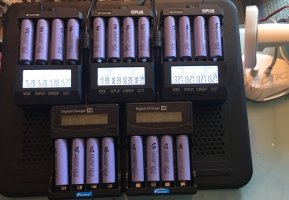Hi Guys,
I've been reading this post with interest, because I have 3000 batteries to process. Currently I'm using four Foxnovo 4S chargers to discharge/charge sixteen batteries concurrently. Given it's taking twelve hours to complete, I'll be here nearly one hundred days!
May I ask, has anyone found a much faster method? I'm thinking choices are either buy more Foxnovo chargers or find another method. I have IMAX chargers, but don't know how to set up nor the pro's and con's.
Can someone please advise.
Many thanks.
Neil
I've been reading this post with interest, because I have 3000 batteries to process. Currently I'm using four Foxnovo 4S chargers to discharge/charge sixteen batteries concurrently. Given it's taking twelve hours to complete, I'll be here nearly one hundred days!
May I ask, has anyone found a much faster method? I'm thinking choices are either buy more Foxnovo chargers or find another method. I have IMAX chargers, but don't know how to set up nor the pro's and con's.
Can someone please advise.
Many thanks.
Neil



